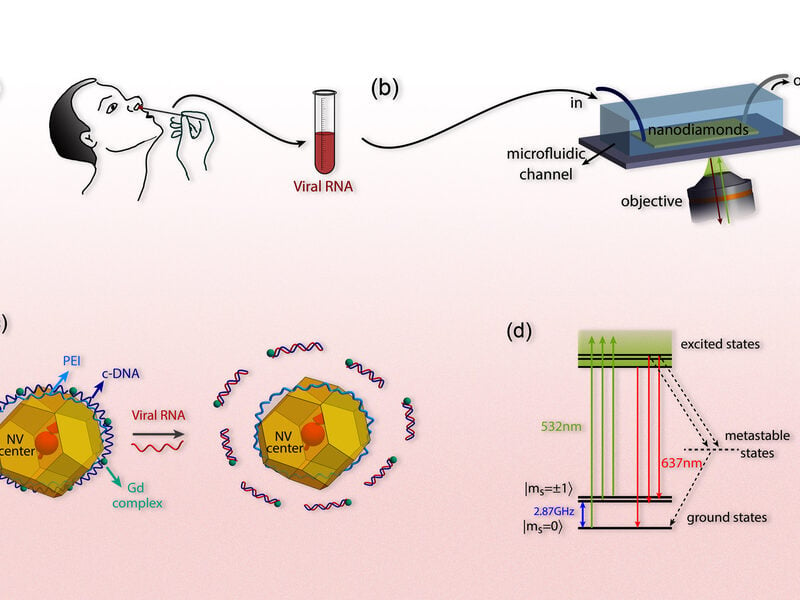
Quantum sensor could detect Covid-19 viruses
Researchers in the US have developed a potential new test for the virus that causes Covid-19 using a diamond-based quantum sensor.
The team at MIT simulated using nitrogen vacancy (NV) centres in artificial diamond layers for a high sensitivity sensor.
Even the gold-standard polymerase chain reaction (PCR) tests might have false-negative rates of more than 25 percent. In contrast, the team’s analysis shows the new test could have false negative rates below 1 percent. The test could also be sensitive enough to detect just a few hundred strands of the viral RNA, within just a second.
The new method would involve coating the nanodiamonds containing these NV centres with a material that is magnetically coupled to them and has been treated to bond only with the specific RNA sequence of the virus. When the virus RNA is present and bonds to this material, it disrupts the magnetic connection and causes changes in the diamond’s fluorescence that are easily detected with a laser-based optical sensor.
The sensor uses only low-cost layers of artificial diamond and the devices could be scaled up to analyze a whole batch of samples at once, the researchers say. The gadolinium-based coating with its RNA-tuned organic molecules can be produced using common chemical processes and materials, and the lasers used to read out the results are comparable to cheap, widely available commercial green laser pointers.
While this initial work was based on detailed mathematical simulations that proved the system can work in principle, the team is continuing to work on translating that into a working lab-scale device to confirm the predictions. “We don’t know how long it will take to do the final demonstration,” said researcher Changhao Li.
- Diamond nanocarbon Bio-FET technology joins Covid-19 fight
- raphene-enhanced Covid-19 sensor detects virus in seconds
- Autonomous machine learning boost for quantum sensors
The plan is create a basic proof-of-principle lab test, and then to work on ways to optimize the system to make it work on real virus diagnosis applications.
The multidisciplinary process requires a combination of expertise in quantum physics and engineering, for producing the detectors themselves, and in chemistry and biology, for developing the molecules that bind with the viral RNA and for finding ways to bond these to the diamond surfaces.
Even if complications arise in translating the theoretical analysis into a working device there is such a large margin of lower false negatives predicted from this work that it will likely still have a strong advantage over standard PCR tests, says Paola Cappellaro, professor of nuclear science and engineering and of physics at MIT.
And even if the accuracy were the same, this method would still have a major advantage in producing its results with a matter of minutes, rather than requiring several hours, she says.
The basic method can be adapted to any virus, she says, including any new ones that may arise, simply by adapting the compounds that are attached to the nanodiamond sensors to match the generic material of the specific target virus.
Other related articles
- Strain turns diamond in to a semiconductor
- Diamond nanofilm slashes power for magnetic sensors
- Bosch boss calls for quantum commitment
Other articles on eeNews Europe
- Collaboration for high definition Virtual Humans
- NNAISENSE moves into AI-based city digital twins
- All change at congatec
- QNX 7 support for i.MX8M board
- Boom year for chip market
 If you enjoyed this article, you will like the following ones: don't miss them by subscribing to :
eeNews on Google News
If you enjoyed this article, you will like the following ones: don't miss them by subscribing to :
eeNews on Google News




